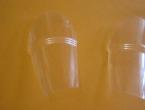Hobbit house inside and out. The Hobbit: The Battle of the Five Armies. Journey through the hobbit houses. What types of cellars are there?
On December 1, the premiere of The Hobbit: The Battle of the Five Armies took place, completing the trilogy about the adventures of Bilbo Baggins and the 13 Dwarves. The film will be released on Russian cinema screens on December 11 this year. For fans of fantasy and adventure, we decided to make a selection of amazing buildings inspired by the works of John Tolkien.
The hobbit village scenes were filmed in the Matanama Hills in New Zealand. Today, these small houses have become a tourist attraction, as well as shelter for the sheep from a nearby farm. The interiors were filmed in a film studio, so you are unlikely to find anything interesting inside the premises, but there is something to do in this place - you can go to a sheep farm and pet the lambs.



Briton Ollie Wotherspoon built a “hobbit hole” for his children in the garden behind his family’s house. It took 2 weeks and 4 thousand pounds to create a home based on the book by John Tolkien. A wood-burning fireplace, carved furniture and a secret tunnel are dug approximately 1.2 m into the ground. The height of the ceilings inside the hobbit's house is almost 2 m.




Simon Dale from Wales independently erected a house that looked like a hobbit hole. The work cost just £3,000 and took about four months. The self-taught builder used only local natural materials and also made some of the furniture with his own hands. The hobbit house is equipped with a stove, cellar and solar panels.





Steve Michaels created the Hobbit House Inn in Montana. The author spent 410 thousand dollars on the construction of the hotel. The main house, measuring 93 square meters, is hidden in a hill at a depth of 9 meters. In addition, the 8 hectare property is equipped with a troll house, several small holes, as well as many sculptures and products.







Bilbo Baggins's home in the Hobbit Village is charmingly cozy, but unsuitable for adults to live in. But children will have a place to frolic and feel like they are in a magical world.

Architect Peter Archer designed a holiday home in Chester County, near Philadelphia, USA. A team of artisans have created a magical home inspired by The Lord of the Rings and The Hobbit.




Specialists from Christian Muller Architects and SeARCH created an unusual “hobbit house” with all the amenities of a modern home. In addition to the recreation area and guest room, the room has an underground tunnel.



It is impossible to imagine a private house or summer cottage without a garden, berry garden or beds of various sizes. And of course, during the season you will definitely harvest a crop that will need to be stored somewhere.
And also the products you want keep fresh on hot summer days... In general, you can’t do without a cellar or basement on your property. What will it be? Above ground cellar, glacier, pile, vegetable shed, wine cellar or buried chamber?
What exactly you choose depends on the goal you are pursuing, the landscape and your capabilities. But in any case, it is worth designing buildings so that they look organically on the site, are easy to use and support the overall style.
The cellar can be hidden and made invisible, or you can deliberately make it a bright, original, attractive element of the garden (focal point).
We offer you 30 ideas for decorating a cellar on the site, from familiar and standard to original and fabulous. Let's see!
Do you remember what houses the hobbits lived in? You can build your own Hobbiton in your garden if your site has hills and uneven surfaces. Yes, even if he doesn’t have them, but you have a great desire to build such a cellar, build it too! Of course, such a cellar requires space, so take a critical look at your space first.


An earthen cellar is the most practical. If you built it according to the rules, then the temperature in it will remain at the same level all year round -3-8 degrees.
Such conditions are ideal for preserving food and storing crops. However, it is not always possible to organize a cellar underground (the reason may be groundwater or marshy areas).
An alternative to it can be a bulk cellar, which built on the surface ground or semi-buried, partially located in the ground. High-quality waterproofing and a good layer of earthen covering will help create conditions similar to those in an underground cellar.







If you approach the issue of the cellar creatively, you can combine business with pleasure and organize a children's slide on it, which will not stand idle either in winter or in summer!
Plan the construction of the cellar so that its entrance is on the north side. With this entrance location, the sun's rays will not affect the temperature inside the cellar.
To enhance the effect, plant herbs, ground cover plants, small shrubs for shading, or arrange container plants on the surface of the cellar. Climbing plants will perfectly hide a bulk cellar from scorching rays and, at the same time, decorate the garden:
- climbing roses
- girl's grapes
- Tekoma
- clematis (clematis)
- honeysuckle







An Alpine slide, a Czech rolling pin, gabions, a gravel garden or a flower bed will perfectly camouflage your cellar, while at the same time being a stylish landscape element.





Wine Vault
A wine cellar must meet certain conditions: it is important to maintain a certain temperature and humidity, as well as install the correct racks for storing wines.
The ideal location for a wine cellar is to place it under the house. Here it is easier to create and maintain the required temperature, and at the same time, save space. However, if a house already stands on the site, it is more realistic to plan the wine cellar as a separate one. To ensure that everything in your cellar is taken into account and designed correctly, we advise you to turn to professionals.
In the design of a wine cellar, natural stone (rubble, sandstone, granite), wood, and accessories that we associate with winemaking (barrels of different sizes will be very useful) are often used.


Friends, in anticipation of the holidays, I think wonderful ideas for hobbit houses will set you up for a fairy-tale perception of life in the best possible way. Such buildings on your summer cottage or country house can be used as children's playrooms, as a storage room, and as a cellar.

This can be a simple frame, covered with plywood and treated with protective impregnation. The roof can also be made of clapboard or wooden planks coated with a layer of wax or varnish.

Don't forget about the traditional round doors and windows for hobbit houses. This will make the building very attractive and cozy.

Let's take a look inside the house! It is recommended to make windows - portholes - on both sides; shelves can be placed on the side slopes.

A beautiful solution that also combines stone raised flower beds, plus a small window in the roof.

In some cases, for example, if you decide to make a cellar, it will be appropriate to cover part of the roof with soil. In this case, the temperature inside the room will remain ideal for storing food even in summer.

In some projects, the windows have a classic square shape, but please note that the door is still round!

In the West, there are passionate people who make similar custom-made hobbit houses. It’s an amazing thing, but it’s in great demand! Beautiful cellar, isn't it?

Or here’s another option, generally almost completely buried in the ground. The walls in this case are made of stone.

Or this, a children's version for games. The house is installed on a wooden platform, covered with boards, on top of which, on the roof, flexible tiles are mounted.

In general, I must admit, such a house can become an excellent place for solitude and creativity, I say this as an artist who needs space for painting, his own workshop.

A beautiful house, with a door and windows that, in combination, resemble an animal’s paw.

Cellar houses with an earthen roof, dug into the hills, are, of course, labor intensive. But such a structure can certainly be used to store your supplies.

Stunning ideas, it seems to me, of course, can only be admired, but probably simpler, easier options can be made on your own plot, without land.

A beautifully decorated, painted house like this will delight you and give your children a lot of summer experiences both from relaxing in the country and from the opportunity to be in a fairy-tale hobbit house.
The value of the harvest collected at the dacha directly depends on its preservation. Insuring the family budget from unnecessary expenses and serving a fresh, vitamin-rich harvest to the table all winter - these are the main tasks that the cellar performs. No home refrigerator, even the size of a linen closet, can replace it.
The word cellar is most often associated with a country house. Here on the veranda or in the kitchen there is a hatch leading to the basement or shallow pit.
Free-standing cellars outside the house for storing vegetables, fruits and canning are less common and many summer residents are practically unfamiliar with them. This article will help you evaluate the advantages, study the varieties and understand the features of the construction of such structures.
The difference between a cellar and a basement
Despite the same purpose, a free-standing cellar is structurally different from a basement. Placing an open-air storage facility requires a reliable roof and powerful insulation.
The need to build a cellar on the territory of a dacha arises in two cases:
- At high groundwater levels.
- For storing large volumes of fruits and vegetables.
The type of structure depends on the water saturation of the soil. Surface storage is built in cases where it is impossible to go deeper into the ground than two or three “bayonets” of a shovel.
If the maximum level of soil water rise is at a depth of 1.5-2.0 meters, then the structure is buried in the ground to half its height. If the aquifer is deep, the storage facility can be completely dug into the ground, leaving a flat roof covered with turf on the surface.

Entrance to a semi-buried cellar
Some may say, why would I make a cellar in the yard when I can dig it under the floor of the kitchen or porch? There are several serious objections to this argument.
First. It is best to dig a cellar under the house during the construction of the building. In the existing dacha, the floors will have to be dismantled, and then, in cramped conditions, tons of earth will have to be manually removed.
Second. The construction of a bulk storage facility under a house can disrupt the soil conditions of the foundation and cause the building to settle.
Third. The ground may contain radioactive radon gas, which will enter residential areas.
Fourth. The dimensions of the basement are limited by the size of the room in which it is located. There are no such limits for a street cellar (storage warehouse).
Fifth. In winter, heat from the house significantly increases the temperature and humidity in the basement, worsening storage conditions and activating the growth process of potatoes.
General information on cellar construction
As we said above, the solution to the question of which cellar is better to make depends on the groundwater level. If they are close to the surface of the earth, then the only option is above-ground storage.

Ground cellar - the best option for damp soil
The original appearance of the above-ground cellar is liked by lovers of rock gardens and other miniature “mountain massifs” created in the country.
As the “upper water” moves away from the surface of the earth, the storage for vegetables and fruits can be lowered deeper.

The lower the water, the deeper the storage

Along with the increase in the depth of a country storage shed, the problems inherent in all underground structures become more acute: the need for high-quality drainage, waterproofing of walls and ceilings. To solve them, a trench is dug along the perimeter of the pit, filled with crushed stone and sand. This reserve “pocket” will collect excess moisture that gets into the ground after melting snow or heavy rains. The walls are backfilled not with earth, but with a crushed stone-sand mixture that drains water into a drainage trench.
Regardless of the quality of drainage, an outdoor cellar needs waterproofing. Today it is easy to do. On the market you can find many hydrophobic impregnations and mastics that protect the bottom and walls of the building from soil moisture.

Water protection is needed outside and inside
Any summer resident knows that long-term storage of crops requires a certain temperature and humidity. In winter, the temperature in the country cellar should be maintained from +2 to +4C with an air humidity of 80 to 90%. It is easy to control using a thermometer and hygrometer. But how to ensure that the room is warm enough and not too damp?
The first problem is solved by insulation. In surface and semi-buried storage facilities, this role is played by the soil used to line the walls.
The best natural heat insulator is peat. Unfortunately, it is quite rare. Therefore, if you decide to build a cellar at your dacha with your own hands, buy polystyrene foam boards 5 or 10 cm thick to insulate the floors and walls. They are covered with earth on top and fixed to the walls with glue or bitumen mastic. To prevent erosion of the embankment soil, it is sown with grass or covered with layers of turf cut from the soil.
The humidity in the storage is regulated by a simple natural ventilation system. It consists of a long supply pipe and a short exhaust pipe.

Pipe A – inflow, pipe B – exhaust
There is a very effective and cheap way to accumulate cold in a storage facility - a glacier. Our great-grandfathers successfully used it to store meat and dairy products. This is a shallow pit with ice (in our time, its walls are made not of wood, but of concrete). There is nothing clever in the design of the glacier, but the cold release from the ice blocks is very impressive and persists for several months.

What types of cellars are there?
The simplest cellar is a wooden frame made of logs, on which a slab rests. A layer of roofing material is laid over it and soil is poured.


This is what a wooden vegetable cellar looks like
Wood, even antiseptic, will not last more than 15 years in a buried storage facility. Therefore, most often the walls of cellars are built from brick, cinder blocks or monolithic reinforced concrete. The ceiling is made from standard hollow-core slabs or using concrete poured over a reinforcement frame.
Sometimes wooden beams are used for the ceiling, between which expanded clay insulation is poured or mineral wool is laid.

Concrete storage slab made from wooden beams

Insulation of floors with expanded clay
For underground storage of vegetables, in addition to concrete and brick, you can use metal or plastic. A finished cellar for a summer residence is a container with stiffening ribs, which is buried in the ground to a given depth. The metal is treated with bitumen coating before installation. Plastic does not need additional protection.

Metal cellar in the process of installation
During the period of seasonal rise of the “high water”, a powerful buoyant force acts on the caisson cellar (Archimedes’ law). Therefore, a prerequisite for its trouble-free operation is the use of ballast - a monolithic or prefabricated concrete slab. It is placed with a crane or poured at the bottom of the pit before installing the tank and secured to it with anchors.
When considering the option of purchasing a ready-made storage unit made of plastic or metal, you need to take into account the following considerations:
- The price of a container for storing fruits and vegetables (including installation) is higher than the cost of building a structure made of concrete or brick.
- Despite the high factory readiness of the caisson, you will not be able to completely abandon excavation and concrete work (a foundation pit and a ballast slab are necessary).
- It is problematic to drive a crane into a developed summer cottage to install a stove and container without damaging green spaces, paths and fences.
The only real advantage of plastic and steel construction is absolute tightness - a factor that is important for a deep cellar.

The average cost of a 5 cubic meter plastic cellar (without installation) is 95 thousand rubles. Installation work will cost 50 thousand rubles.
The approximate price of a metal storage facility of the same volume (walls made of steel sheet 5 mm thick) is 85 thousand rubles. You will have to pay at least 45,000 rubles for installation.
When looking for an inexpensive option for outdoor vegetable storage, pay attention to concrete rings. They are used for septic tanks and other underground structures. By making a concrete base and installing several rings on it, you will get a reliable shelter for the grown crop.

Factories make not only round, but also rectangular concrete sections
The floor in the cellar made of prefabricated rings and its walls must be treated inside and outside with a waterproofing compound (coating or impregnation). A prerequisite for tightness is the presence of joining locks on the concrete sections.

Construction of the underground storage facility is nearing completion
You won’t have to manually cast a concrete lid for such a cellar. It can be bought together with rings.
If there is old slate lying idle on the farm, then the problem with the cellar can be considered solved. Having made a frame from a corner or pipes, it is lowered into the prepared pit. After this, the slate sheets are attached to the profile with self-tapping screws.

A slate cellar on a metal frame is a simple and inexpensive option
After preparing the sand and crushed stone and installing the reinforcing mesh, the bottom is filled with concrete. The next stage is laying electrical wiring, coating the slate and frame with bitumen mastic. The work is completed by concreting the floor and backfilling.

Monolithic slate ceiling
Regardless of the type of material used to build the walls, a well-executed cellar floor design includes several layers indicated in the diagram.

Floor design
To conclude our review, we will consider two options for above-ground mini-storages. The first of them is a “box” made of boards with a gable roof and a door. By insulating the space between its outer and inner lining with mineral wool (thickness of at least 150 mm), you will get inexpensive and functional storage.

The second option for an above-ground mini-cellar is a structure attached to the wall of the house. The benefit of this solution is twofold: saving space and one finished wall.

The ceiling here is made of boards covered with crumpled clay and a layer of roofing felt. The embankment is made with soil, which after laying is moistened, compacted and covered with turf.




